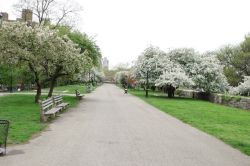Riverside Park
Ten Mile River Playground
Riverside Park, one of only eight officially designated scenic landmarks in the City of New York, has a long and storied history. The rugged bluffs and rocky outcroppings created through prehistoric glacial deposits once descended directly to the Hudson River shore and were densely wooded during the Native American habitation. In 1846 the Hudson River Railroad was cut through the forested hillside. Acknowledging the city’s expansion northward, Central Park Commissioner William R. Martin proposed in 1865 that a scenic drive and park be built on Manhattan’s Upper West Side. The land between the heights and the railroad was bought by the City over the next two years.
Frederick Law Olmsted (1822-1903), renowned co-designer of Central and Prospect Parks, was retained in 1873 and submitted a plan in 1875 combining park and parkway into a synthesized landscape which adhered to the general topographical contours of hill and dale. Over the next twenty-five years park designs developed under a succession of landscape architects, including Olmsted’s partner Calvert Vaux (1824-1895) and Samuel Parsons (1844-1923). The result, stretching then from West 72nd to 125th Streets, was a grand tree-lined boulevard, an English-style rustic park with informally arranged trees and shrubs, contrasting natural enclosures and open vistas.
The development of the park encouraged the construction of mansions along the drive. At the turn of the century, a movement dubbed the "City Beautiful" sought to promote a more dignified civic architecture, and found expression in the formal neo-classical detailing of the park’s extension from the 125th Street viaduct to 155th Street. Monuments placed along the Drive during this era included Grant’s Tomb (1897), the Soldiers and Sailors Memorial (1902), the Firemen’s Memorial (1913), and Joan of Arc (1915).
The increased rail traffic and waterfront industries founded on landfill extending the shoreline led to an outcry by wealthy residents for municipal action against these uses as unpleasant to the park and community. After decades of discussion a massive park expansion plan, crafted by architect Clinton Lloyd with landscape architect Gilmore Clarke, was implemented between 1934 and 1937 under Parks Commissioner Robert Moses. The park was widened westward by 148 acres, and the Henry Hudson Parkway, ball fields, esplanade, 79th Street marina and rotunda were added to it.
This playground is called Ten Mile River Playground because it is located approximately ten miles from the southern tip of Manhattan. A $450,000 renovation was funded in 1995 by Councilmember Stanley E. Michels. The new design includes a bicycle rack, swings, basketball and volleyball courts, and play equipment. Another feature is a pond-theme spray shower which serves as home to two bronze beavers, a reference to the extensive fur trading which took place along the Hudson River in the 17th and 18th centuries.
Check out your park's Vital Signs
Clean & Safe
Green & Resilient
Empowered & Engaged Users
Share your feedback or learn more about how this park is part of a
Vital Park System

Know Before You Go
Related inquiries may be sent to boatbasin@parks.nyc.gov
Related inquiries may be sent to boatbasin@parks.nyc.gov


